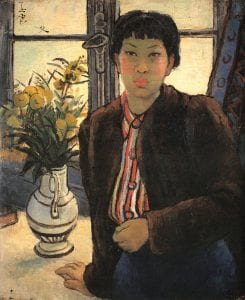 Pan Yulaing – Self Portrait (1945), Oil on canvas, 73.5 x 60 cm
Pan Yulaing – Self Portrait (1945), Oil on canvas, 73.5 x 60 cm
Source: A Century in Crisis, page 169 (figure 69)
Pan Yulaing (1895-1977) is best known for her female nude paintings but I decided to focus on one of her self portraits for my visual analysis as I feel they best embody the spirit of my topic. Pan Yulaing painted many self-portraits over the course of her life, giving us a better glimpse into her life, each one a reflection of her self-preception. The painting I chose, Self Portrait (1945), was painted by Pan Yulaing in Paris a few years after she moved back to Europe for good (Andrews and Shen 1998: 178). Painting in the western style of oil on canvas, Pan uses a mix of post-impressionist styles with hints of fauvism influence, reflecting her western training, although the colors she uses in this painting are darker and more serious (Andrews and Shen 1998: 178).
In this painting, Self Portrait (1945), Pan Yuliang depicts herself standing in front of a closed window confidently leaning one hand against a table with a vase of yellow flowers. Unlike many of her other self-portraits where Pan depicts herself dressed in traditional Chinese garb, in this portrait she is wearing her hair up while dressed in simple western-style clothing, showing her struggle with her Chinese identity. Her bright, rosy cheeks and pink lips are contrasted by bulky winter clothes that hide her feminine figure with dark, traditionally non-feminine, colors and patterns.
Pan’s facial expression is serious and confident, portraying an air of professionalism. In opposition to social customs which dictated that women must avert their gaze as a show of modesty (Ng 2019: 26), Pan Yuliang stares straight ahead with a penetrating and unflinchingly direct gaze, challenging the preconceived notions of how women should act. The yellow blossoms behind her are reminiscent of classic feminine ideals and the vase suggestive of the outdated views of women she was forced to fight against her whole life. In traditional Chinese culture, women were often compared to flower vases, equating them to a fragile decorative object with no substance (Ng 2019: 25). By juxtaposing herself next to the vase of flowers (a reoccurring theme in many of her self-portraits) she confronts these antiquated and oppressive ideas, challenging viewers with her piercing gaze. She paints herself as a complex human being rather than as a clichéd ornamental beauty that women were so often portrayed as in art.
Works Cited:
Andrews, Julia Frances, and Kuiyi Shen. A Century in Crisis: Modernity and Tradition in the Art of Twentieth-Century China. Guggenheim Museum Publications, 1998.
Ng, Sandy. “The Art of Pan Yuliang: Fashioning the Self in Modern China.” Woman’s Art Journal 40, no. 1 (2019): 21–31.


I really liked reading about your artist self portrait and the idea of self reflection. When I wrote my piece I did not think about the ways that my artists piece could have been affected by his own self reflection in a way. I think an artists way of thinking of themselves affects their art and I really like how you mention that when analyzing your piece.
I really like your post, as it helped me expanding my thinking. I must say that before seeing this, I only considered the clothing a woman wore in the picture, or expressions in her face to consider the western-style painting, and I find my way at first really swallow as I did not dig more into the context, how she be depicted comparing with the background, the proportion of the picture, and not only how her faces expressed but also her gestures, her hair,.. I also really like the insight you can give in your post, about the insightful meaning of putting flowers next to her. Your work really helps me a lot about considering a painting carefully, and I want to say thank you.